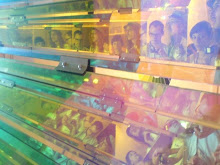
A Better World by Design Conference
Providence, RI :: RISD/Brown
November 6-9, 2008
Niti Bhan : Emerging Futures Lab
It is so silly that we spend the majority of our talent and time designing for the top 10% of the population (economically speaking), there’s a huge opportunity and though it may not seem sexy and cutting edge, we’re missing out (though I do think we can make it sexy and cutting edge). Representing the voice of the user, Niti presented her evidence in a very design applicable format. As we consider designing for the BoP, our current understanding of the word “customer” must shift… a lot.
Providence, RI :: RISD/Brown
November 6-9, 2008
Niti Bhan : Emerging Futures Lab
It is so silly that we spend the majority of our talent and time designing for the top 10% of the population (economically speaking), there’s a huge opportunity and though it may not seem sexy and cutting edge, we’re missing out (though I do think we can make it sexy and cutting edge). Representing the voice of the user, Niti presented her evidence in a very design applicable format. As we consider designing for the BoP, our current understanding of the word “customer” must shift… a lot.
“Uncertainty is the only certainty”
Meaning, the majority of customers in the developing world cannot plan. Their income is uncertain which greatly affects purchasing patterns. This population is constantly waiting; waiting on work, waiting on infrastructure- buses, clean water, etc. Systems like our two year phone contracts are simply out of the question. Consider “pay as you go” systems. Whether that’s pay as you go phone plans or “pay as you go” groceries (buying only what you need, single use sachets, etc.), we need to understand that this isn’t about generating a consumer but meeting needs.
“Life is hard, make it easy to use and easy to choose”
In terms of consumerism, the all-in-one, greatest and latest product won’t survive. It’s not the way the “system” works. Niti’s example for this subject was again a reference to how cell phones succeed in the developing world. You have the “calls only” version (maybe doesn’t even have a screen) for a minimum price, the next step up has a very simple and obvious change in features- maybe it has text messaging. The services and upgrade in the premium model makes it very clear to the customer what they are purchasing. There aren’t extra features- “bull shit”- for the customer to question their true value (therefore losing respect and trust in that brand).
“Trade-offs are a fact of life”
Everything is a trade off in this culture. Do I buy a newspaper today and possibly not have money for milk tomorrow? Pointing towards the last paragraph, really expose the value/lack of value. Create a transparent brand. These products will not be thrown away, they will be reused and refurbished and people will capitalize on this cycle (do we have cell phone repair shops in the U.S?). It is not our goal to make consumers out of this market. Oh how I wish we too thought of purchases as trade-offs and not just in the monetary sense, but in the “natural resources/waste/disposal of” sense.
In closing, Niti left us with these principles (forgive me if I repeat something) that could very easily become design priorities and directives:
Uncover and map the values gap.
Maximize constraints, minimize resources.
Maximize the “freemium” (i.e. Flikr)
Cross pollination first- why reinvent the wheel?
Got it? Good.
Next up in my notebook, Ecolect. Thank god someone is finally creating a database. Here’s to hoping it is as successful and dependable as we’re all expecting it to be. In this session we discussed the “Triple Bottom Line” which I never actually wrote down, but it looked something like a ven diagram and I’m just assuming the three circles had something to do with everything you would put into a life cycle analysis. What I took away from this is
1. we need a database so we have access to materials
2. we need a database so we can evaluate the footprint of these materials
3. we need a well developed/streamlined way to conduct an LCA
All of which are very involved and in constant flux (is organic cotton better than regular cotton? Ceramic mug or recycled paper cup? Paper or plastic? Ahh!) So, I suggest we stop making things. We stop and use and reuse what we have and clean up what we’ve done. I’m only half joking.
Finally, one of the the last presentations was Aliza Peleg from “Better Place” (Shai Agassi’s EV dream).
They first showed this adorable movie. Made me feel all soft and fuzzy like a marshmallow.
watch it here
In my opinion “Better Place” is a good senior thesis. It’s that ideal world that makes sense but people love to dump on it b/c they’re realists. Better Place describes themselves as “A mobility operator that delivers transportation as a sustainable service”.
Yay.
My question- feel free to answer if you have one- so we’re taking combustion engines off the road and replacing them with batteries that have huge eco-footprints. I understand that they will recharge them as long as possible BUT you can’t recharge them forever right? And when you can no longer recharge them we will all of a sudden have a huge issue with massive amounts of waste. How are they approaching the development of the battery technology? Has someone figured out how to control this responsibly? Also, why do we keep taking major dumps on the big three? I don’t approve bailouts but helloooo Ford, GM, and Chrysler are American as apple pie. Patriotism anyone? Comments on the subject are invited and encouraged.


No comments:
Post a Comment